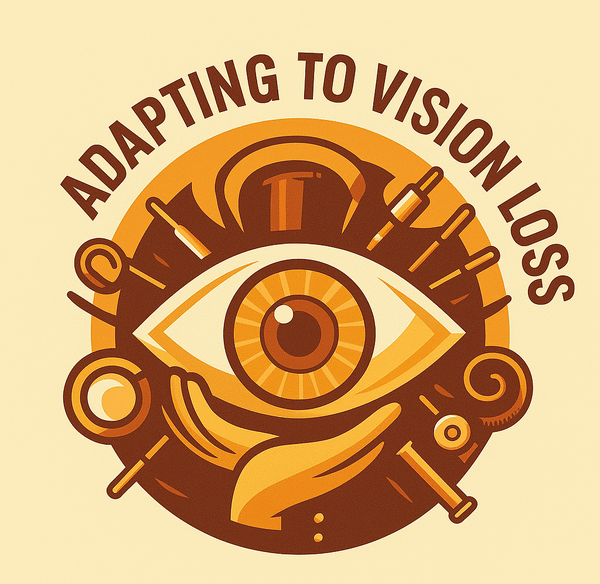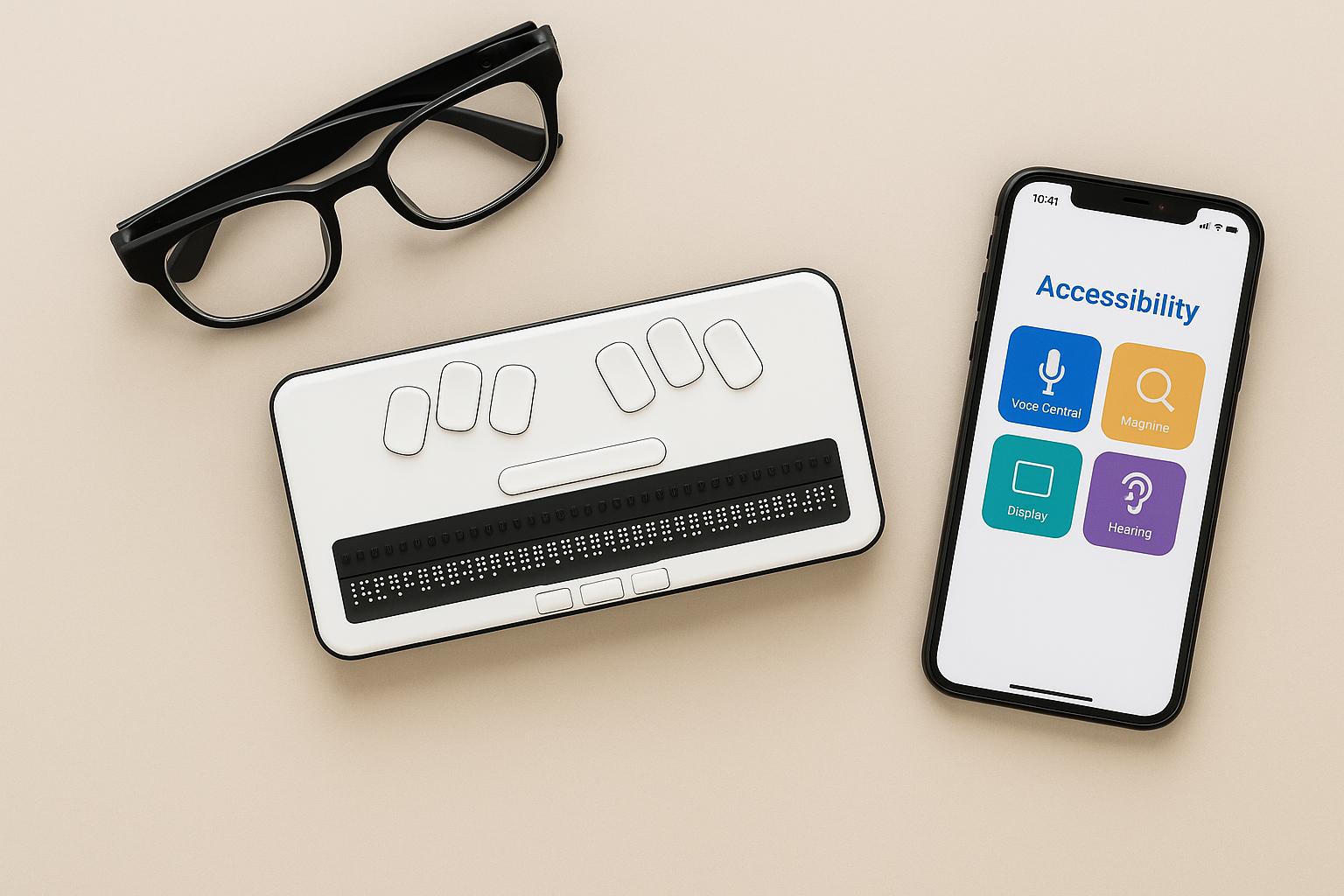First published November 2024 — Updated for 2025
When I first wrote this article, I was caught up in the excitement of new technology. Every headline seemed to promise another breakthrough for people with vision loss, and I wanted to capture that energy. A year later, I can look back with clearer eyes. Some of those innovations are still with us, stronger than ever. Others have fizzled. And a few brand-new ideas have arrived that I never would have expected.
So, let’s take a walk together through what’s still useful, what’s new, and what real people are actually saying about these visual impairment aids in everyday life.
🔄 The Tools That Still Deserve a Place
Some devices I wrote about in 2024 have become part of daily routines, almost without fanfare.
Take smart glasses, for example. Envision and OrCam MyEye haven’t disappeared. In fact, they’ve gotten better. Updates have smoothed out the voices and made object recognition less clunky. Meanwhile, Ray-Ban and Meta teamed up to produce a pair of glasses that don’t even advertise themselves as “assistive” — but they quietly include features that matter to us. To me, that’s a hopeful sign: mainstream companies are finally realizing accessibility isn’t optional.
 Ray-Ban Meta smart glasses — blending fashion with accessibility for daily independence.
Ray-Ban Meta smart glasses — blending fashion with accessibility for daily independence.
Then there are Braille e-readers. A few years ago, they felt futuristic and fragile. Now, models like the Dot Pad are sturdier and a little more affordable. They’re not perfect, but they’re no longer just gadgets for early adopters — students and professionals are actually putting them to work every day.
 Smart home devices like Amazon Echo make daily tasks more accessible through simple voice commands.
Smart home devices like Amazon Echo make daily tasks more accessible through simple voice commands.
And I can’t skip over smart home devices. They go way beyond just Alexa or Google Home Assistant. What started as a convenience (“Alexa, turn on the lights”) is quickly becoming essential. I’ve been surprised to see appliances like washing machines and ovens embracing voice commands. For someone who remembers when even microwaves were a challenge, it feels like we’ve entered a new era.
 Hands using an electronic braille reader — advancing literacy and independence for people with visual impairments.
Hands using an electronic braille reader — advancing literacy and independence for people with visual impairments.
✨ What’s New in 2025
Of course, technology doesn’t stand still. This year has introduced some intriguing newcomers.
Wearable magnifiers and AR headsets are a big one. I’ve tried a few, and while they still feel experimental, they’re lighter and less awkward than the clunky goggles we saw a few years back. Devices like the IrisVision Inspire are starting to feel less like “equipment” and more like something you might actually put on before heading out the door.
 Wearable magnifiers and AR headsets enhance vision in a lightweight, user-friendly design.
Wearable magnifiers and AR headsets enhance vision in a lightweight, user-friendly design.
Navigation has also shifted. When Microsoft retired Soundscape, it left a hole. But now, apps like Lazarillo and GoodMaps Explore are stepping in. They don’t just bark out directions — they’re trying to paint a picture of the world around you. I see this as part of a bigger move toward independence, not just orientation.
 Navigation apps with audio provide clear, step-by-step guidance for visually impaired users on the go.
Navigation apps with audio provide clear, step-by-step guidance for visually impaired users on the go.
And then there’s health management. Talking pill organizers that used to just beep now connect to smartphones, giving audio reminders when refills are due. My Apple Watch has also become more helpful, with subtle taps on the wrist reminding me of things without breaking into my thoughts. It’s funny how a tiny vibration can sometimes be more useful than a voice prompt.
👥 What Real Users Are Saying
Fancy product announcements are one thing. Living with these devices day after day is another.
Smart canes are a good example. Although many people use and appreciate the features of the WeWALK Cane, feedback is mixed. Some users love the navigation support and connectivity, while others find that a traditional white cane still suits them better for its simplicity and reliability. The key takeaway seems to be that it depends on your lifestyle and comfort level — what feels empowering for one person may feel unnecessary for another.
I’ve also heard mixed reviews about color identifiers. Dedicated gadgets often struggle with accuracy. More than one person has told me, half-laughing, that their “color reader” has called navy blue black one too many times. Interestingly, the apps on our phones — Seeing AI, Be My Eyes — often do a better job than the expensive stand-alone tools.
And while virtual reality training still feels like a niche experiment, it’s quietly gaining traction in rehabilitation centers. I can see why: for someone newly diagnosed, the chance to practice orientation skills in a safe, controlled setting can be less intimidating than stepping out into a noisy street.
🛠 Choosing What Works for You
I’ve come to believe that the best tool isn’t the flashiest or the most expensive — it’s the one that fits your life.
If your budget is tight, free apps and simple bump dots can be just as empowering as high-end gadgets. If you’re living in a busy downtown area, navigation tools might feel like a lifeline. If you’re mostly at home, smart appliances could change your day-to-day comfort more than anything else.
And perhaps most importantly, if a device feels too complicated to use regularly, it won’t help. I’ve learned the hard way that “ease of use” is the deciding factor. A tool you actually reach for is worth more than the fanciest tech that gathers dust.
 Comparison snapshot of key visual impairment aids, showing features and best uses in 2025.
Comparison snapshot of key visual impairment aids, showing features and best uses in 2025.
📌 Looking Ahead
What excites me most isn’t the next shiny gadget. It’s the fact that mainstream technology is finally starting to build accessibility in from the ground up. When Ray-Ban and Meta produce glasses with features we can use, or when a major appliance brand makes voice controls standard, that’s a cultural shift — not just a product release.
For those of us adapting to vision loss, it means less searching for “specialty” gear and more being able to use the same devices as everyone else. That’s independence on a whole new level.
So yes, it’s time to update this article. The landscape has changed. The goal hasn’t: to share what’s real, what works, and what actually helps us live our lives more fully.

